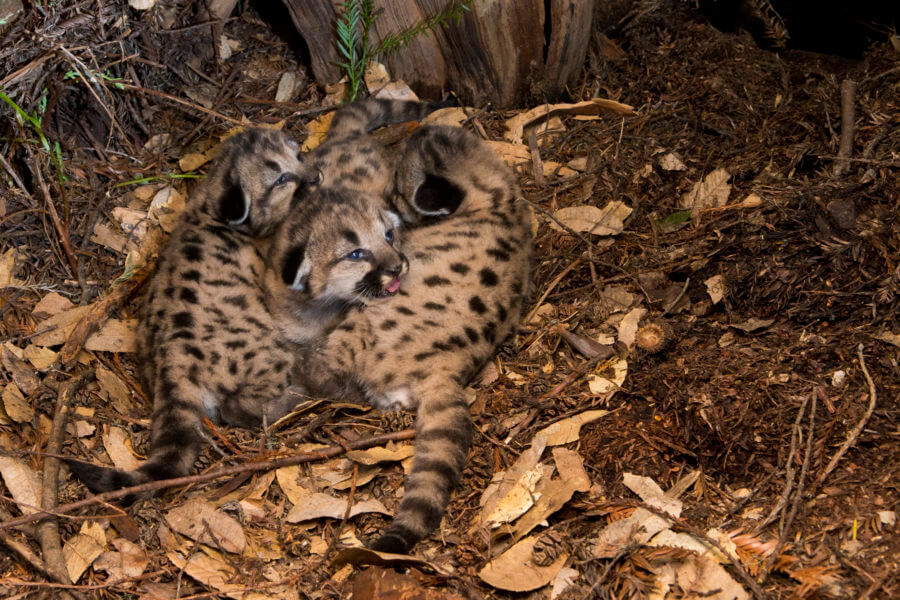The Life and Times of Pumas
The Life and Times of Pumas
Endangered Cats Need Healthy Habitat to Thrive
By Richie King, Field Biologist, Santa Cruz Puma Project
Pumas—also known as mountain lions, panthers, and catamounts—thrive when they can range from mountain top to mountain top. Unfortunately, in the Santa Cruz mountains, their range is interrupted frequently, particularly by developed lands and roads, making it difficult for the species to survive. In fact, only 40 pumas are known to be active in the region.
We have a lot of work to do to protect and expand their habitat and support conservation conditions for their healthy development and growth. But how do pumas develop and grow?
Read on to learn about the life cycle of pumas and their families over time.
You can also learn more about the Puma Project from director Chris Wilmers' Under the Redwoods episode or his SemperVoices interview.
Kittens (0-18 months)

Mountain Lion (Puma concolor) kittens in den, Santa Cruz Puma Project, Santa Cruz mountains, California
Kittens are born blind and deaf and are completely reliant on their mother for survival. After about two weeks the kittens will begin to open their eyes. They have blue eyes at birth and as the kittens age they will transition to a brown or amber. Puma kittens are also born with spots that will slowly fade over time. At around two months the mother will begin to take their kittens to her killsites and at three months she will start to wean them off of milk.
The kittens will stay with their mother until they are ready to venture out on their own, at about two years old. Female pumas will spend 80% of their adult lives raising and having kittens. This time spent with mother is crucial to acquiring the skills needed to be successful. They will learn prey recognition, how to hunt, how to successfully take down prey, as well as many other survival traits.
Sub-adults (18-36 months)

Sub adults in the Santa Cruz mountains, Santa Cruz Puma Project
A 1.5-2.5 year old puma that has or is beginning to disperse away from its mother is considered a sub-adult. They are also called transients or dispersers. After dispersal they will sometimes travel with littermates for a short time but are most often alone.
Female pumas will oftentimes stay near to their natal home range while male pumas tend to disperse further away. Male pumas will sometimes travel great distances during these dispersal events. One male puma that dispersed from the South Dakota Black Hills was later found in Connecticut. He had traveled around 1,500 miles!
Dispersal is a dangerous time for the puma as it often involves crossing roads, entering through urban areas, and encountering other predatory adult male pumas. Dispersal is one of the main vectors for reproduction and ensuring healthy diversity in the gene pool.
Adults (36 months+)

Adult puma, 4M, Santa Cruz Puma Project, Santa Cruz mountains, California
Once they have established a home range pumas may live up to 12-13 years in the wild. Puma home ranges vary widely by each state and even within states. Here in the Santa Cruz mountains an average male home-range will be 100 square miles, while a female puma will range about 30 square miles. In certain areas in Arizona the home ranges can be 2-3x these ranges. A typical male home range will have multiple female home ranges within or overlapping with his own.
Male pumas will fight to defend their home range to keep other male pumas or dispersing males out of the area. Cover, prey availability, urban sprawl, and other factors influence the size of puma home range.
The number one prey for a mountain lion are ungulates, or hooved mammals. Here in the Santa Cruz mountains deer will make up over 80% of their diet. They can take down deer of any size and will typically feed on the carcass multiple nights in a row and cache it during the day while they find a spot to bed down. A cached carcass is when they cover the kill in sticks, leaves, and substrate and is typically done by pawing at the ground around the kill.

Adult puma caching a kill with leaves and debris. Santa Cruz Puma Project, Santa Cruz mountains, California.
Puma society
A typical female puma will reach maturity at about 2 years old. They go into estrus—a recurring period of sexual receptivity and fertility in many female mammals—about once every 23 days. They can give birth any time of the year although in North America there is a birth pulse in the spring and summer months. The typical litter for mountain lions is between 1 and 4 with the gestation period being 82-98 days. Adult females will have one successful litter once every two to three years.
It was once believed that pumas only interacted during breeding and then went about their solitary life, but recent research has shown that it is a little more complicated than that. A study done in the Grand Tetons has found that pumas live in a much more interconnected community. They interact with each other with regularity while using food as a sort of social currency. Female pumas with kittens have been shown feeding at kills with other females and her kittens. Males have been shown feeding at kills with other females. GPS data has shown that these interactions are not anomalies or one-off events. These puma communities will typically consist of one adult male and the multiple females within his home range. Those within this male’s home range will interact with each more often than pumas in other areas.
Learn more
Check out more resources about pumas and research that is helping Sempervirens Fund protect and expand their critical habitats.

